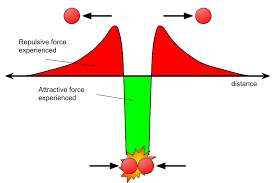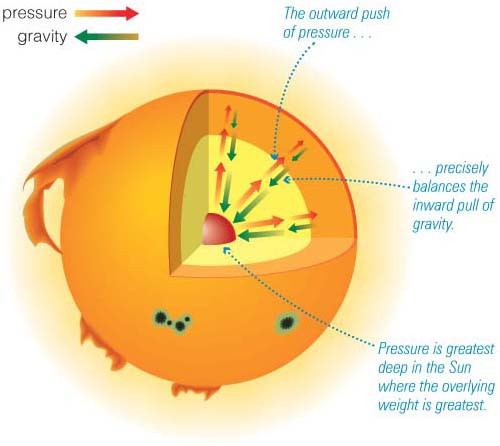
When I first began learning about stars, I expected them to be violent and chaotic places. And to an extent, they certainly are.
Pressures are unbelievably high in their cores—high enough to smash protons together, and this is no small feat. And near their surfaces, magnetic field loops twist and tangle and a number of eruptions disrupt satellite function on Earth from time to time.
Beyond the obvious, though, stars are actually surprisingly…peaceful.
While stable, they only produce enough energy to sustain their own mass. Their way of maintaining homeostasis is beautiful in its simplicity.
But this can’t last forever. Eventually, stars exhaust their hydrogen fuel. Their cores begin to contract and their outer envelope expands to enormous proportions.
What’s next for a star—and why?
First, let’s review a few old concepts that are important to understanding the evolution of a medium-mass star.
Does this guy look familiar?

This is an atom, the most fundamental building block of the universe. Every substance that exists is made up of different combinations of atoms, and every atom is made up of different combinations of subatomic particles.
The most important subatomic particle to stellar astronomy is the proton—also known as a hydrogen nucleus. It’s fundamental to energy production in stars.
Meet the proton-proton chain.

This process may be familiar to you already. Essentially, four protons are smashed together by the immense pressure in the core of a star. In order to do this, stars must overcome the Coulomb barrier—that’s the force that tries to stop two particles with the same charge from colliding.
You’ve seen this before. How hard is it to stick two matching ends of magnets together?
You probably can’t manage to do it, especially if the magnets are particularly strong. But it’s difficult even when they’re small. It’s even more difficult to smash them together so hard they actually fuse.
Stars have a high enough internal pressure to manage this—and they depend on fusing protons in order to generate energy.

It’s important to note that the Coulomb barrier gets harder to break as the repulsive force between same-charged particles gets stronger. And it gets stronger as you add more of the same-charged particles.
In other words, if you try to smash four protons together (as in the proton-proton chain), it’s easier than if you increased the number of protons and tried to smash six.
Alright, let’s get back to the proton-proton chain. Notice that the end result is a helium nucleus?
As stars fuse hydrogen nuclei for fuel, they dump helium “ashes” into the center of their cores. These helium nuclei have twice the protons of hydrogen, so the Coulomb barrier is twice as strong. Even the immense pressures in stars’ cores aren’t enough to overcome it…yet.
For most of a star’s lifespan, it is stable. Its internal pressure wages a constant battle against the force of its own gravity.

A star’s internal pressure is sustained by its energy production. What if its energy production fluctuates?
That’s when a truly beautiful dynamic kicks in: the pressure-temperature thermostat.
This mechanism manages to precisely balance energy production for as long as the star fuses hydrogen in its core. If energy production ever falls, the star compensates. If it ever rises, again, the star compensates.
In this way, the star manages to maintain hydrostatic equilibrium, which is basically a star’s version of homeostasis.

But this pressure-temperature thermostat doesn’t work forever. Eventually, the star will run out of hydrogen to fuse in its core. The core then begins to contract under its own weight, which actually generates thermal energy.
This doesn’t stabilize the core. Instead, the core acts like a stovetop, igniting hydrogen fusion in a layer of the star surrounding the core. This layer burns outward through the star like a brushfire.
Meanwhile, the core continues to contract…and finally, it grows hot enough—about 100,000,000 K—to fuse the inert helium ashes that hydrogen fusion left behind.
So…what does the interior of the star look like right now?

Right now, we’re looking at the star right as it begins helium core fusion.
Helium fusion is usually referred to as the triple alpha process. Why? Because three helium nuclei are needed to fuse, and astronomers also call helium nuclei alpha particles.
And as for why they call them that…well, beats me. I’m assuming it’s something to do with the physics of light. Either that, or quantum mechanics. But I could be wrong.
Anyway, here is the long-awaited triple-alpha process:

Notice that two helium nuclei fuse to create a beryllium nucleus, which then fuses with one more helium nucleus to create a carbon nucleus.
Ooh, we’re finally talking about carbon nuclei in stars. I’ve been looking forward to this.
Now you realize why I mentioned smashing together six protons, don’t you? That’s the total amount of protons we have to fuse during the triple-alpha process.
So…how does helium fusion actually happen?
Well, that depends on the star.

Massive stars—those farther up the main sequence, as we call it—have it easy. They’re able to gradually begin fusing helium as their cores begin to contract and their outer layers begin to expand. They have enough mass that pressures are already high enough to break a higher Coulomb barrier.
As for medium-mass stars, however…
These stars do not have enough mass to start fusing the helium ashes that fall into their centers. The core continues to contract under its own weight until the pressure-temperature thermostat completely breaks down. The core becomes degenerate.

In other words…the core is so tightly packed that the free-floating electrons in the star suddenly matter.
Because there’s more of them than there are helium nuclei, they control the pressure in the core. But they get so densely packed that they literally can’t fit any closer together. They also get “stuck,” so to speak, moving at certain speeds. Essentially, the pressure in the core cannot increase or decrease. It’s stuck, but…
…but the temperature of the core depends on the nuclei, and they aren’t stuck. They’re still whizzing about and generating energy. The pressure can’t increase or decrease, but the temperature keeps rising—uncontrollably.
The result…

…is what we call a helium flash.
Remember that in the degenerate core, the temperature—controlled by the nuclei—continues to rise. So eventually, the core will get hot enough to ignite the triple-alpha process. When that happens, nuclear energy is generated.
There’s just one problem…the pressure-temperature thermostat isn’t working. In a more massive star, the core would respond by expanding and reducing the pressure, so that nuclear reactions would slow down. But this is impossible in a degenerate core.
Instead, we get a runaway explosion so violent that, for a moment, the helium core generates more than 1,000,000,000,000 times as much energy per second as the sun.
Um, people…that’s actually comparable to the combined luminosity of all the stars in our galaxy.
Yeah. Pretty crazy, huh?
But…wait a second. Wouldn’t an explosion that powerful destroy the star?
Surprisingly…it doesn’t. And here’s why.

Compared to the rest of the expanding star…helium-fusing core is tiny. (Keep in mind that 1 R☉ is equal to the radius of our sun. Similarly, 1 M☉ is equal to the mass of our sun.)
Because the helium core is so small and the star’s expanding envelope is so darn huge, most of the energy from the helium flash actually goes into heating the core or is absorbed by the expanding envelope.
The helium flash is also over very quickly. In a matter of seconds, the core becomes hot enough that it is no longer degenerate. The pressure-temperature thermostat is able to kick back in.
The star is then able to bring helium fusion back under control, and begins fusing helium steadily in its core.
Now that we’ve seen how different types of stars begin to fuse helium, what’s next for a star?
At this point, main-sequence evolution diverges into medium-mass evolution after the helium flash and high-mass evolution after helium begins to gradually fuse. We’ll explore what comes next for different stars coming up.
Hi Emma, when a helium flash occurs, (or after it occurs), is there any observable physical evidence that we can pick up, such as:
(i) increased radiation emissions at any wavelength?
(ii) spectroscopic observations?
(iii) a change in diameter?
(iv) repositioning on the HR diagram?
Is it possible for us to know which evolutionary stage a star has reached – or is the evidence all concealed deep in the core?
LikeLike